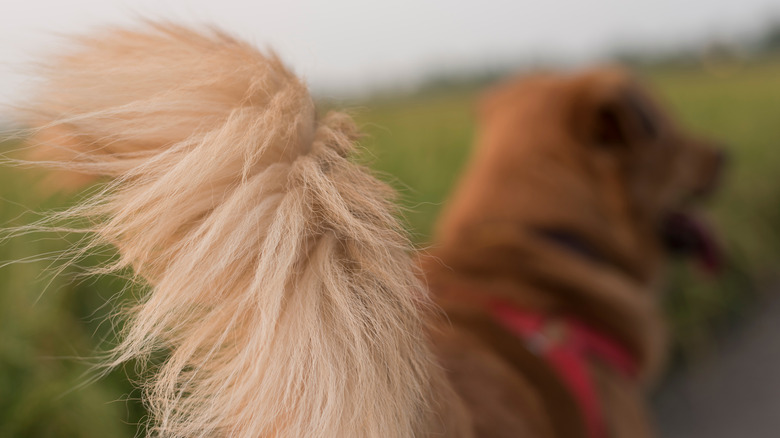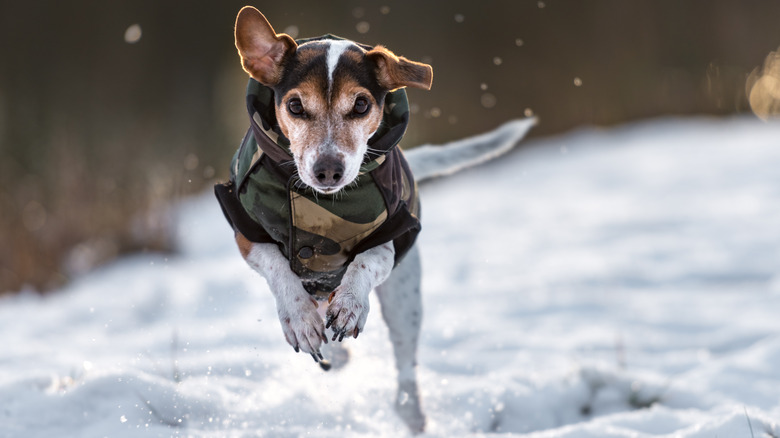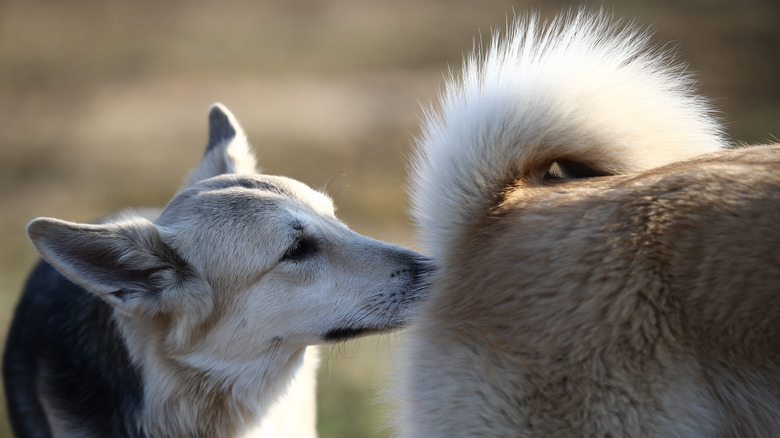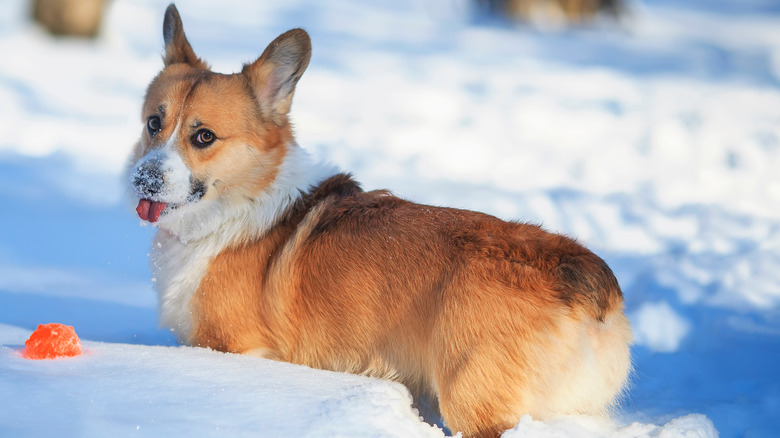The Real Reasons Dogs Have Tails
Anyone who has spent any time around dogs knows that wagging tails are pretty much a good sign. But is that the reason dogs have tails, to tell the world when they are happy? It turns out, the tail has many uses, according to the American Kennel Club. Tails help dogs move, balance, and communicate in multiple ways. Some tail use varies by breed and location. For example, northern dog breeds like Siberian huskies use their fluffy tails to cover their nose and face when at rest outside in the cold.
According to veterinarian Matthew McCarthy in an interview with Reader's Digest, the dog's tail is an extension of the backbone: interlocking vertebrae wrapped in muscle and packed with blood vessels and nerves. The tail is flexible and powerful, able to move in all directions. This is necessary for the multiple ways in which dogs use their tails each day.
Movement and balance
Tails help a dog move, steer, and balance, according to Psychology Today. When a running dog changes direction, the tail will point in the direction of the turn to provide a counterweight, allowing the dog to complete a high-speed turn without toppling. Fast-running dogs such as sighthounds have whip-like tails for precisely this purpose, points out the American Kennel Club.
Likewise, when walking on a narrow surface, a dog can use its tail to balance. Once again, the tail becomes a counterweight, pointing in one direction as the dog leans in another, "much the same way a circus tightrope walker uses a balance bar," Dr. McCarthy explains in Reader's Digest. But tails are not just useful on land: They also help dogs move and steer underwater. Dogs that swim a lot, such as retrievers, have tails that are thick enough to act as rudders, according to the American Kennel Club.
Communicating by odor
Dr. Sarah Wooten, a veterinarian interviewed by MSN, explains the importance of tails when it comes to how dogs communicate. Setting aside barks for the moment, "dogs are largely nonverbal communicators," Dr. Wooten says, "which means that they use their bodies, including their tails, to communicate something." A big part of dog communication has to do with their keen sense of smell.
According to Psychology Today, dogs have scent glands located under the tail that release pheromones, or scents used for communication. The smell each dog emits from its glands is unique and therefore identifiable, much the way every person has unique fingerprints. A wagging tail acts as a fan to spread each dog's unique scent around to announce its presence to other dogs, and the position of the tail matters. Dominant dogs who hold their tails high release more scent than submissive or frightened dogs, who keep their tails low to mask their own scent.
Communicating emotions, needs, and intentions
Tail communication involves so much more than spreading and masking scent. Dogs use their tails to communicate their emotions, needs, and intentions in a way that is understood by other dogs, and even perceptive non-dogs (such as humans) who share their space. Most people are familiar with the frantically wagging tail held aloft, which means a dog is happy. But according to Dr. Sarah Wooten, the veterinarian interviewed by MSN, a dog's tail communicates a range of emotions. Frightened dogs tuck their tails. Curious dogs hold their tails straight out, parallel to the ground. There are nuances to tail language that experts are just finding out, such as the discovery that dogs will wag their tails toward the right when feeling particularly positive (reported in Correspondence, posted at Current Biology).
When in the mood to fight, dogs hold their tails high, sometimes arching over their backs. "The higher the tail, the more aggressive the dog," Dr. Wooten explains. Another important cue for humans to pick up on: When a dog is happily wagging but then suddenly stops, Dr. Wooten says, it's "usually a communication that the dog doesn't really want to be touched and wants to be left alone."
Tail wagging in puppies: nature or nurture?
Humans who study dogs disagree on whether tail language is learned or instinctual. Dr. Sarah Wooten, speaking to MSN, argues that tail language is learned. "Puppies learn to wag their tails around 1 month of age," she says. "They learn from their mother, and they use it to communicate with their mother and siblings." On the other hand, Dr. Jamie Freyer says in an interview with Reader's Digest that tail wagging is instinctual. Her colleague Dr. Matthew McCarthy agrees, comparing the dog's tail to the human eyebrow, which moves to betray emotion in a way the person is not always in control of.
Dr. Stanley Coren, writing for Psychology Today, points out that newborn puppies don't wag their tails at first, despite being physically able to do so. The first three weeks of a puppy's life are spent sleeping and eating, so communication is unnecessary. As puppies move around and start interacting with one another, that's when they start using their tails to communicate with their mother and siblings. There appears to be trial and error as they learn the art of wagging. Dr. Coren points out that the pre-wiring of social communication in puppies isn't fully understood yet, but what does seem to be clear is that "learning is clearly needed to refine the use and interpretation of these signals."
Tailless dogs
Though tails are important for movement, balance, and communication, not every dog has a functional tail. Several breeds have naturally bobbed or extremely short tails, like the Pembroke Welsh Corgi (pictured). Some dogs have a genetic mutation causing them to have bobbed tails, according to Reader's Digest. Other dog species traditionally have their tails docked, or removed, as puppies. Docking can cause dogs to feel "ghost pain" where their tails would be, according to MSN.
Dr. Jamie Freyer, quoted by Reader's Digest, points out that dogs without tails are at a disadvantage in terms of communicating with other dogs. Dogs without tails are twice as likely to have negative encounters at the dog park as will dogs with tails. However, tailless dogs are still able to communicate. They get by on facial expressions and wagging other parts of their bodies. "The wiggle starts at the chest or shoulders," explains Dr. Freyer, "and if it's a French bulldog, the wiggle starts at the ears."





